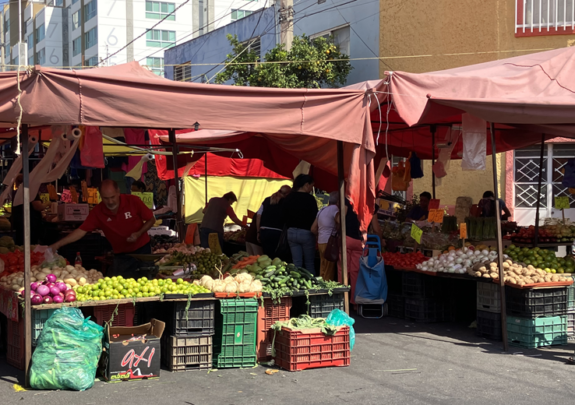As a newly arrived expat trying to figure out how to grocery shop in Mexico, you’ll soon encounter the word tianguis, derived from the Nahuatl word tiyānquiztli meaning ‘open-air market.’
For those not well-versed in Mexico’s pre-Hispanic era, Nahuatl was the common language used by the indigenous people of the Aztec Empire.
The practice of buying and selling at temporary outdoor markets is deeply embedded in Mexican culture. While tianguis play a more important role in the daily life of rural Mexicans due to the limited number of physical stores in these areas, it’s safe to say that tianguis remain an important institution nationwide.
Whether you reside in Mexico City or a small pueblo, you are sure to find vibrant weekly street markets, operating pretty much as they always have. In smaller towns where modern Mexican grocery stores don’t exist, tianguis may be the only game in town.
There are some truly phenomenal tianguis here in Guadalajara. But before we dive into a tour, it helps to have a basic understanding of how they operate.
How Tianguis Operate
For those accustomed to shopping farmer’s markets in the U.S., Mexican street markets will upend pretty much everything you’ve learned.
In Mexico, the freshest and best-tasting food comes from tianguis and generally costs A LOT LESS than the same items purchased in supermarkets. This was a revelation to me, having nearly sworn off farmer’s markets in the U.S. due to the astronomical prices.
While everyone loves low prices, there are a few new concepts to understand when shopping tianguis for the first time.
Minimal Transparency. Prices for food (or anything else) are rarely posted in tianguis. Shoppers must ask vendors for their prices, and then decide if they want to pay them.
Cash only. Do not show up to a tianguis expecting to pay with anything but cold hard cash. While the merchandise has certainly evolved to reflect more modern consumer tastes, there’s been no evolution in payment methods at street markets.
Moreover, it will be very hard to transact if you carry only large notes. To save yourself and the vendors extra time and trouble, it’s best to bring a stack of small peso notes, e.g. $20s, $50s and $100s when you shop. Otherwise, a vendor is likely to have to dash around hitting up other vendors to make change for you.
Dynamic Pricing. Stemming from the lack of transparency, vendors also employ what’s known as dynamic pricing when selling their products. The easiest way to understand this concept is with a few examples:
#1: The restaurant guy who buys huge quantities of produce (or whatever) each week is getting a better price than you.
#2: The little old lady living on a fixed income who’s been shopping the same tianguis for 40 years (and knows the vendors’ life stories) is getting a better price than you.
#3: Any customer speaking Spanish is getting a better price than any customer speaking English. This may not be true 100% of the time, but pretty close.
In essence, if a vendor doesn’t know you and/or thinks that you can afford to pay a bit more, you’ll get charged more. This is dynamic pricing in action, and it’s applied to Mexicans too.
To be clear, these are not problems to be solved. This is just the way things work in the tianguis; so it’s best to accept them and move on.
Why? Because there’s a silver lining.
By shopping at tianguis even gringos spend much less than if they bought all the same stuff at a Soriana or Fresko. And best of all, everything tastes better too!
Street markets also enable you to avoid a lot of plastic packaging ubiquitous at big retail chains, assuming you bring your own reusable bags.
How to Shop Tianguis for the Best Results
There are two things you can do proactively to obtain better pricing in tianguis, not to mention have more fun shopping.
1. Speak Spanish
Even if you’re not able to speak like a native, Mexicans will greatly appreciate the effort, and be less likely to jack up the price of whatever it is you have your eye on.
Nothing says “arrogant gringo” like unapologetically speaking English — and expecting locals to speak it back to you — in a Spanish-speaking country. I saw this behavior daily on a two-week jaunt through Ajijic in Lake Chapala, and it left me embarrassed and anxious to get back to Guadalajara.
2. Visit the same vendors each week
Unless you have a really bad experience with someone, it pays to visit the same vendors each week.
By patronizing the same stalls and — as you get more confident in Spanish — making small talk with the sellers, they’ll start to see you as a regular and greet you warmly. Little by little, you’ll probably start to receive little perks and better prices from these folks.
Bonus Tip: If you’re watching every peso, another strategy is to shop tianguis later in the day. If the vendor hasn’t run out of product, they may offer you a better price on perishable items they want to sell rather than haul back home. It doesn’t always work — but worth trying because sometimes it does.
Now that you’ve got a foundation in how Mexican tianguis work, give it a try and maybe skip that weekly trip to the supermarket!
And please keep an eye out for my next post, where we’ll tour some of Guadalajara’s best tianguis!

